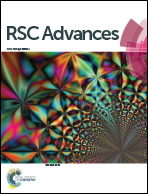Solution processed transparent nanoparticulate ZnO thin film electrode for photoelectrochemical water oxidation
Abstract
A non-aqueous solution processing route followed by dip-coating has been developed to deposit a ZnO thin film with average nanoparticle size of around 21 nm. The optical, morphological and structural characterization of the film is studied in order to confirm its band gap, particle size distribution and crystallographic properties. Finally the photoelectrochemical studies of different layers of deposited ZnO films has shown that the optimized film for 2 layer deposition at 500 °C exhibits an anodic photocurrent density of 1 mA cm−2 without any modification. Surprisingly the photocurrent density at a water splitting potential of 1.23 V is quite high with a magnitude of 0.817 mA cm−2. The photocurrent experiment is followed by chopped light investigation in order to have information about the charge transfer characteristics and here the absence of a cathodic spike rules out any recombination effect in the bulk of the ZnO electrode. In this study, we also propose that this kind of transparent electrode having photoelectrochemical functionality can be used as a large window panel in a modern house with the aim of performing dual purpose work: UV filtering and photoelectrochemical water splitting. The evolved oxygen by the electrode is further quantified with an in situ gas chromatographic study.


 Please wait while we load your content...
Please wait while we load your content...